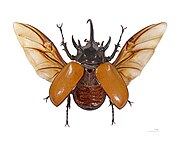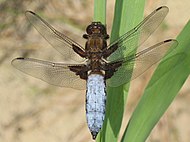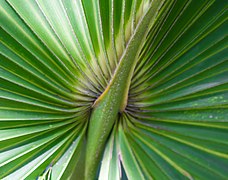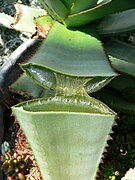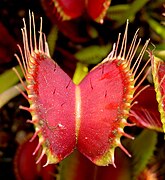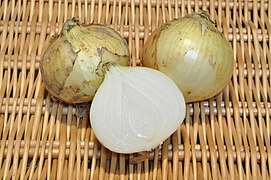Homology (biology)
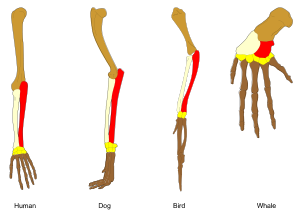
Inbiology,homologyis similarity due to sharedancestrybetween a pair of structures orgenesin differenttaxa.A common example ofhomologousstructures is the forelimbs ofvertebrates,where thewings of batsandbirds,the arms ofprimates,the front flippers ofwhales,and the forelegs offour-leggedvertebrates likedogsandcrocodilesare all derived from the same ancestraltetrapodstructure.Evolutionary biologyexplains homologous structuresadaptedto different purposes as the result of descent with modification from acommon ancestor.The term was first applied to biology in a non-evolutionary context by the anatomistRichard Owenin 1843. Homology was later explained byCharles Darwin's theory of evolution in 1859, but had been observed before this, fromAristotleonwards, and it was explicitly analysed byPierre Belonin 1555.
Indevelopmental biology,organs that developed in the embryo in the same manner and from similar origins, such as from matchingprimordiain successive segments of the same animal, areserially homologous.Examples include the legs of acentipede,themaxillary palpandlabial palpof an insect, and thespinous processesof successivevertebraein avertebral column.Male and femalereproductive organsare homologous if they develop from the same embryonic tissue, as do theovariesandtesticlesof mammals including humans.[citation needed]
Sequence homologybetweenproteinorDNA sequencesis similarly defined in terms of shared ancestry. Two segments ofDNAcan have shared ancestry because of either aspeciationevent (orthologs) or aduplication event(paralogs). Homology among proteins or DNA is inferred from their sequence similarity. Significant similarity is strong evidence that two sequences are related bydivergent evolutionfrom a common ancestor.Alignmentsof multiple sequences are used to discover the homologous regions.
Homology remains controversial inanimal behaviour,but there is suggestive evidence that, for example,dominance hierarchiesare homologous across theprimates.
History
[edit]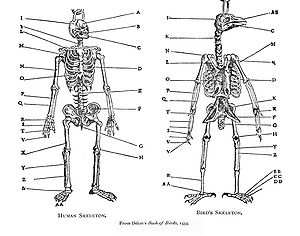
Homology was noticed byAristotle(c. 350 BC),[1]and was explicitly analysed byPierre Belonin his 1555Book of Birds,where he systematically compared the skeletons of birds and humans. The pattern of similarity was interpreted as part of the staticgreat chain of beingthrough themediaevalandearly modernperiods: it was not then seen as implying evolutionary change. In the GermanNaturphilosophietradition, homology was of special interest as demonstrating unity in nature.[2][3]In 1790,Goethestated hisfoliar theoryin his essay "Metamorphosis of Plants", showing that flower parts are derived from leaves.[4]Theserial homologyof limbs was described late in the 18th century. The French zoologistEtienne Geoffroy Saint-Hilaireshowed in 1818 in histheorie d'analogue( "theory of homologues" ) that structures were shared between fishes, reptiles, birds, and mammals.[5]When Geoffroy went further and sought homologies betweenGeorges Cuvier'sembranchements,such as vertebrates and molluscs, his claims triggered the 1830Cuvier-Geoffroy debate.Geoffroy stated the principle of connections, namely that what is important is the relative position of different structures and their connections to each other.[3]EmbryologistKarl Ernst von Baerstated what are now calledvon Baer's lawsin 1828, noting that related animals begin their development as similar embryos and then diverge: thus, animals in the samefamilyare more closely related and diverge later than animals which are only in the sameorderand have fewer homologies. Von Baer's theory recognises that eachtaxon(such as a family) has distinctive shared features, and that embryonic development parallels the taxonomic hierarchy: not the same asrecapitulation theory.[3]The term "homology" was first used in biology by the anatomistRichard Owenin 1843 when studying the similarities of vertebratefinsand limbs, defining it as the "same organ in different animals under every variety of form and function",[6]and contrasting it with the matching term "analogy" which he used to describe different structures with the same function. Owen codified 3 main criteria for determining if features were homologous: position, development, and composition. In 1859,Charles Darwinexplained homologous structures as meaning that the organisms concerned shared abody planfrom a common ancestor, and that taxa were branches of a singletree of life.[2][7][3]
Definition
[edit]The word homology, coined in about 1656, is derived from theGreekὁμόλογοςhomologosfrom ὁμόςhomos'same' and λόγοςlogos'relation'.[8][9][a]
Similar biological structures or sequences in differenttaxaare homologous if they are derived from acommon ancestor.Homology thus impliesdivergent evolution.For example, manyinsects(such asdragonflies) possess two pairs of flyingwings.Inbeetles,the first pair of wings has evolved into a pair ofhard wing covers,[12]while inDipteranflies the second pair of wings has evolved into smallhalteresused for balance.[b][13]
Similarly, the forelimbs of ancestralvertebrateshave evolved into the front flippers ofwhales,the wings ofbirds,the running forelegs ofdogs,deer,andhorses,the short forelegs offrogsandlizards,and the graspinghandsofprimatesincluding humans. The same major forearm bones (humerus,radius,andulna[c]) are found in fossils oflobe-finned fishsuch asEusthenopteron.[14]
Homology vs. analogy
[edit]
The opposite of homologous organs are analogous organs which do similar jobs in two taxa that were notpresent in their most recent common ancestorbut ratherevolved separately.For example, thewings of insectsand birds evolved independently inwidely separated groups,and converged functionally to support poweredflight,so they are analogous. Similarly, the wings of asycamore mapleseed and the wings of a bird are analogous but not homologous, as they develop from quite different structures.[15][16]A structure can be homologous at one level, but only analogous at another.Pterosaur,birdandbat wingsare analogous as wings, but homologous as forelimbs because the organ served as a forearm (not a wing) in the last common ancestor oftetrapods,and evolved in different ways in the three groups. Thus, in the pterosaurs, the "wing" involves both the forelimb and the hindlimb.[17]Analogy is calledhomoplasyincladistics,andconvergent or parallel evolutionin evolutionary biology.[18][19]
In cladistics
[edit]Specialised terms are used in taxonomic research. Primary homology is a researcher's initial hypothesis based on similar structure or anatomical connections, suggesting that a character state in two or more taxa share is shared due to common ancestry. Primary homology may be conceptually broken down further: we may consider all of the states of the same character as "homologous" parts of a single, unspecified, transformation series. This has been referred to as topographical correspondence. For example, in an aligned DNA sequence matrix, all of the A, G, C, T or implied gaps at a given nucleotide site are homologous in this way. Character state identity is the hypothesis that the particular condition in two or more taxa is "the same" as far as our character coding scheme is concerned. Thus, two Adenines at the same aligned nucleotide site are hypothesized to be homologous unless that hypothesis is subsequently contradicted by other evidence. Secondary homology is implied byparsimony analysis,where a character state that arises only once on a tree is taken to be homologous.[20][21]As implied in this definition, manycladistsconsider secondary homology to be synonymous withsynapomorphy,a shared derived character ortraitstate that distinguishes acladefrom other organisms.[22][23][24]
Shared ancestral character states, symplesiomorphies, represent either synapomorphies of a more inclusive group, or complementary states (often absences) that unite no natural group of organisms. For example, the presence of wings is a synapomorphy for pterygote insects, but a symplesiomorphy for holometabolous insects. Absence of wings in non-pterygote insects and other organisms is a complementary symplesiomorphy that unites no group (for example, absence of wings provides no evidence of common ancestry of silverfish, spiders and annelid worms). On the other hand, absence (or secondary loss) of wings is a synapomorphy for fleas. Patterns such as these lead many cladists to consider the concept of homology and the concept of synapomorphy to be equivalent.[25][24]Some cladists follow the pre-cladistic definition of homology of Haas and Simpson,[26]and view both synapomorphies and symplesiomorphies as homologous character states.[27]
In different taxa
[edit]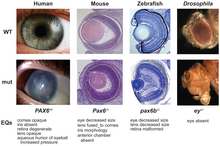
Homologies provide the fundamental basis for all biological classification, although some may be highly counter-intuitive. For example,deep homologieslike thepax6genes that control the development of the eyes of vertebrates and arthropods were unexpected, as the organs are anatomically dissimilar and appeared to have evolved entirely independently.[28][29]
In arthropods
[edit]The embryonic body segments (somites) of differentarthropodtaxa have diverged from a simple body plan with many similar appendages which are serially homologous, into a variety of body plans with fewer segments equipped with specialised appendages.[30]The homologies between these have been discovered by comparinggenesinevolutionary developmental biology.[28]
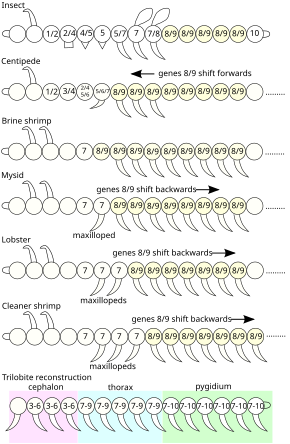
| Somite (body segment) |
Trilobite (Trilobitomorpha) 
|
Spider (Chelicerata) 
|
Centipede (Myriapoda) |
Insect (Hexapoda) 
|
Shrimp (Crustacea) 
|
|---|---|---|---|---|---|
| 1 | antennae | chelicerae(jaws and fangs) | antennae | antennae | 1st antennae |
| 2 | 1st legs | pedipalps | - | - | 2nd antennae |
| 3 | 2nd legs | 1st legs | mandibles | mandibles | mandibles (jaws) |
| 4 | 3rd legs | 2nd legs | 1stmaxillae | 1st maxillae | 1st maxillae |
| 5 | 4th legs | 3rd legs | 2nd maxillae | 2nd maxillae | 2nd maxillae |
| 6 | 5th legs | 4th legs | collum (no legs) | 1st legs | 1st legs |
| 7 | 6th legs | - | 1st legs | 2nd legs | 2nd legs |
| 8 | 7th legs | - | 2nd legs | 3rd legs | 3rd legs |
| 9 | 8th legs | - | 3rd legs | - | 4th legs |
| 10 | 9th legs | - | 4th legs | - | 5th legs |
Among insects, thestingerof the femalehoney beeis a modifiedovipositor,homologous with ovipositors in other insects such as theOrthoptera,Hemiptera,and thoseHymenopterawithout stingers.[31]
In mammals
[edit]The three small bones in themiddle earof mammals including humans, themalleus,incus,andstapes,are today used to transmit sound from theeardrumto theinner ear.The malleus and incus develop in the embryo from structures that form jaw bones (the quadrate and the articular) in lizards, and in fossils of lizard-like ancestors of mammals. Both lines of evidence show that these bones are homologous, sharing a common ancestor.[32]
Among the manyhomologies in mammal reproductive systems,ovariesandtesticlesare homologous.[33]
Rudimentary organs such as the humantailbone,now much reduced from their functional state, are readily understood as signs ofevolution,the explanation being that they were cut down bynatural selectionfrom functioning organs when their functions were no longer needed, but make no sense at all if species are considered to be fixed. The tailbone is homologous to the tails of other primates.[34]
In plants
[edit]Leaves, stems, and roots
[edit]In many plants, defensive or storage structures are made by modifications of the development of primaryleaves,stems,androots.Leaves are variously modified fromphotosyntheticstructures to form the insect-trapping pitchers ofpitcher plants,the insect-trapping jaws ofVenus flytrap,and the spines ofcactuses,all homologous.[35]
| Primary organs | Defensive structures | Storage structures |
|---|---|---|
| Leaves | Spines | Swollen leaves (e.g.succulents) |
| Stems | Thorns | Tubers (e.g.potato), rhizomes (e.g.ginger), fleshy stems (e.g.cacti) |
| Roots | - | Root tubers (e.g.sweet potato), taproot (e.g.carrot) |
Certaincompound leavesof flowering plants are partially homologous both to leaves and shoots, because theirdevelopment has evolvedfrom agenetic mosaicof leaf and shoot development.[36][37]
-
Onepinnateleaf ofEuropean ash
-
Detail ofpalmleaf
-
The very large leaves of the banana,Musa acuminata
-
Insect-trapping leaf ofVenus flytrap
-
Insect-trapping leaf ofpitcher plant
Flower parts
[edit]
The four types of flower parts, namelycarpels,stamens,petals,andsepals,are homologous with and derived from leaves, asGoethecorrectly noted in 1790. The development of these parts through a pattern ofgene expressionin the growing zones (meristems) is described by theABC model of flower development.Each of the four types of flower parts is serially repeated in concentric whorls, controlled by a small number of genes acting in various combinations. Thus, A genes working alone result in sepal formation; A and B together produce petals; B and C together create stamens; C alone produces carpels. When none of the genes are active, leaves are formed. Two more groups of genes, D to formovulesand E for the floral whorls, complete the model. The genes are evidently ancient, as old as theflowering plantsthemselves.[4]
Developmental biology
[edit]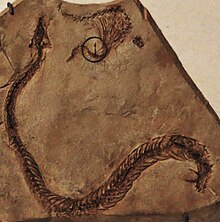
Developmental biologycan identify homologous structures that arose from the same tissue inembryogenesis.For example, adultsnakeshave no legs, but their early embryos have limb-buds for hind legs, which are soon lost as the embryos develop. The implication that the ancestors of snakes had hind legs is confirmed byfossilevidence: theCretaceoussnakePachyrhachis problematicushad hind legs complete with hip bones (ilium,pubis,ischium), thigh bone (femur), leg bones (tibia,fibula) and foot bones (calcaneum,astragalus) as in tetrapods with legs today.[38]
Sequence homology
[edit]
As with anatomical structures,sequence homologybetweenproteinorDNA sequencesis defined in terms of shared ancestry. Two segments of DNA can have shared ancestry because of either aspeciationevent (orthologs) or aduplication event(paralogs). Homology among proteins or DNA is typically inferred from their sequence similarity. Significant similarity is strong evidence that two sequences are related by divergent evolution of a common ancestor.Alignmentsof multiple sequences are used to indicate which regions of each sequence are homologous.[40]
Homologous sequences are orthologous if they are descended from the same ancestral sequence separated by aspeciationevent: when a species diverges into two separate species, the copies of a single gene in the two resulting species are said to beorthologous.The term "ortholog" was coined in 1970 by themolecular evolutionistWalter Fitch.[41]
Homologous sequences are paralogous if they were created by a duplication event within the genome. Forgene duplicationevents, if a gene in an organism is duplicated, the two copies are paralogous. They can shape the structure of whole genomes and thus explain genome evolution to a large extent. Examples include theHomeobox(Hox) genes in animals. These genes not only underwent gene duplications withinchromosomesbut alsowhole genome duplications.As a result, Hox genes in most vertebrates are spread across multiple chromosomes: the HoxA–D clusters are the best studied.[42]
Some sequences are homologous, but they have diverged so much that their sequence similarity is not sufficient to establish homology. However, many proteins have retained very similar structures, andstructural alignmentcan be used to demonstrate their homology.[43]
In behaviour
[edit]It has been suggested that somebehavioursmight be homologous, based either on sharing across related taxa or on common origins of the behaviour in an individual's development; however, the notion of homologous behavior remains controversial,[44]largely because behavior is more prone tomultiple realizabilitythan other biological traits. For example, D. W. Rajecki and Randall C. Flanery, using data on humans and on nonhumanprimates,argue that patterns of behaviour indominance hierarchiesare homologous across the primates.[45]
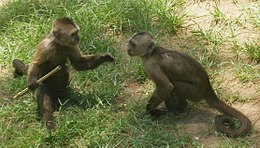
As with morphological features or DNA, shared similarity in behavior provides evidence for common ancestry.[46]The hypothesis that a behavioral character is not homologous should be based on an incongruent distribution of that character with respect to other features that are presumed to reflect the true pattern of relationships. This is an application of Willi Hennig's[47]auxiliary principle.
Notes
[edit]- ^The alternative terms "homogeny" and "homogenous" were also used in the late 1800s and early 1900s. However, these terms are now archaic in biology, and the term "homogenous" is now generally found as a misspelling of the term "homogeneous"which refers to the uniformity of a mixture.[10][11]
- ^If the two pairs of wings are considered as interchangeable, homologous structures, this may be described as a parallel reduction in the number of wings, but otherwise the two changes are each divergent changes in one pair of wings.
- ^These are coloured in the lead image: humerus brown, radius pale buff, ulna red.
References
[edit]- ^abPanchen, A. L. (1999). "Homology — History of a Concept".Novartis Foundation Symposium 222 - Homology.Novartis Foundation Symposia. Vol. 222. pp. 5–18, discussion 18–23.doi:10.1002/9780470515655.ch2.ISBN9780470515655.PMID10332750.
- ^abPanchen, A. L. (1999). "Homology — History of a Concept".Novartis Foundation Symposium 222 - Homology.Novartis Foundation Symposia. Vol. 222. pp. 5–18.doi:10.1002/9780470515655.ch2.ISBN9780470515655.PMID10332750.
{{cite book}}:|journal=ignored (help) - ^abcdBrigandt, Ingo (23 November 2011)."Essay: Homology".The Embryo Project Encyclopedia.
- ^abDornelas, Marcelo Carnier; Dornelas, Odair (2005)."From leaf to flower: Revisiting Goethe's concepts on the ¨metamorphosis¨ of plants".Brazilian Journal of Plant Physiology.17(4): 335–344.doi:10.1590/S1677-04202005000400001.
- ^Geoffroy Saint-Hilaire, Etienne (1818).Philosophie anatomique. Vol. 1: Des organes respiratoires sous le rapport de la détermination et de l'identité de leurs piecès osseuses.Vol. 1. Paris: J. B. Baillière.
- ^Owen, Richard (1843).Lectures on the Comparative Anatomy and Physiology of the Invertebrate Animals, Delivered at the Royal College of Surgeons in 1843.Longman, Brown, Green, and Longmans. pp. 374, 379.
- ^Sommer, R. J. (July 2008). "Homology and the hierarchy of biological systems".BioEssays.30(7): 653–658.doi:10.1002/bies.20776.PMID18536034.
- ^Bower, Frederick Orpen (1906)."Plant Morphology".Congress of Arts and Science: Universal Exposition, St. Louis, 1904.Houghton, Mifflin. p. 64.
- ^Williams, David Malcolm; Forey, Peter L. (2004).Milestones in Systematics.CRC Press. p.198.ISBN978-0-415-28032-7.
- ^"homogeneous, adj.". OED Online. March 2016. Oxford University Press.http:// oed /view/Entry/88045?(accessed April 09, 2016).
- ^"homogenous, adj.". OED Online. March 2016. Oxford University Press.http:// oed /view/Entry/88055?(accessed April 09, 2016).
- ^Wagner, Günter P. (2014).Homology, Genes, and Evolutionary Innovation.Princeton University Press. pp. 53–54.ISBN978-1-4008-5146-1.
elytra have very little similarity with typical wings, but are clearly homologous to forewings. Hence butterflies, flies, and beetles all have two pairs of dorsal appendages that are homologous among species.
- ^Lipshitz, Howard D. (2012).Genes, Development and Cancer: The Life and Work of Edward B. Lewis.Springer. p. 240.ISBN978-1-4419-8981-9.
For example, wing and haltere are homologous, yet widely divergent, organs that normally arise as dorsal appendages of the second thoracic (T2) and third thoracic (T3) segments, respectively.
- ^"Homology: Legs and Limbs".UC Berkeley.Retrieved15 December2016.
- ^"Secret Found to Flight of 'Helicopter Seeds'".LiveScience. 11 June 2009.Retrieved2 March2017.
- ^Lentink, D.; Dickson, W. B.; van Leeuwen, J. L.; Dickinson, M. H. (12 June 2009)."Leading-Edge Vortices Elevate Lift of Autorotating Plant Seeds"(PDF).Science.324(5933): 1438–1440.Bibcode:2009Sci...324.1438L.doi:10.1126/science.1174196.PMID19520959.S2CID12216605.
- ^Scotland, R. W. (2010). "Deep homology: A view from systematics".BioEssays.32(5): 438–449.doi:10.1002/bies.200900175.PMID20394064.S2CID205469918.
- ^Cf. Butler, A. B.:Homology and Homoplasty.In: Squire, Larry R. (Ed.):Encyclopedia of Neuroscience,Academic Press, 2009, pp. 1195–1199.
- ^"Homologous structure vs. analogous structure: What is the difference?".Retrieved27 September2016.
- ^de Pinna, M. C. C. (1991). "Concepts and Tests of homology in the cladistic paradigm".Cladistics.7(4): 367–394.CiteSeerX10.1.1.487.2259.doi:10.1111/j.1096-0031.1991.tb00045.x.S2CID3551391.
- ^Brower, Andrew V. Z.; Schawaroch, V. (1996). "Three steps of homology assessment".Cladistics.12(3): 265–272.doi:10.1111/j.1096-0031.1996.tb00014.x.PMID34920625.S2CID85385271.
- ^Page, Roderick D.M.; Holmes, Edward C. (2009).Molecular Evolution: A Phylogenetic Approach.John Wiley & Sons.ISBN978-1-4443-1336-9.
- ^Brower, Andrew V. Z.; de Pinna, Mario C. C. (24 May 2012)."Homology and errors".Cladistics.28(5): 529–538.doi:10.1111/j.1096-0031.2012.00398.x.PMID34844384.S2CID86806203.
- ^abBrower, Andrew V. Z.; de Pinna, M. C. C. (2014). "About Nothing".Cladistics.30(3): 330–336.doi:10.1111/cla.12050.PMID34788975.S2CID221550586.
- ^Patterson, C. (1982). "Morphological characters and homology". In K. A. Joysey; A. E. Friday (eds.).Problems of Phylogenetic Reconstruction.London and New York: Academic Press. pp. 21–74.
- ^Haas, O. and G. G. Simpson. 1946. Analysis of some phylogenetic terms, with attempts at redefinition.Proc. Amer. Phil. Soc.90:319-349.
- ^Nixon, K. C.; Carpenter, J. M. (2011)."On homology".Cladistics.28(2): 160–169.doi:10.1111/j.1096-0031.2011.00371.x.PMID34861754.S2CID221582887.
- ^abBrusca, R. C.; Brusca, G. J. (1990).Invertebrates.Sinauer Associates. p.669.
- ^Carroll, Sean B.(2006).Endless Forms Most Beautiful.Weidenfeld & Nicolson. pp. 28, 66–69.ISBN978-0-297-85094-6.
- ^Hall, Brian (2008).Homology.John Wiley. p. 29.ISBN978-0-470-51566-2.
- ^Shing, H.; Erickson, E. H. (1982)."Some ultrastructure of the honeybee (Apis melliferaL.) sting ".Apidologie.13(3): 203–213.doi:10.1051/apido:19820301.
- ^"Homology: From jaws to ears — an unusual example of a homology".UC Berkeley.Retrieved15 December2016.
- ^Hyde, Janet Shibley;DeLamater, John D.(June 2010)."Chapter 5"(PDF).Understanding Human Sexuality(11th ed.). New York:McGraw-Hill.p. 103.ISBN978-0-07-338282-1.
- ^Larson, Edward J.(2004).Evolution: The Remarkable History of Scientific Theory.Modern Library. p. 112.ISBN978-0-679-64288-6.
- ^"Homology: Leave it to the plants".University of California at Berkeley.Retrieved7 May2017.
- ^Sattler, R. (1984). "Homology — a continuing challenge".Systematic Botany.9(4): 382–394.doi:10.2307/2418787.JSTOR2418787.
- ^Sattler, R. (1994). "Homology, homeosis, and process morphology in plants". In Hall, Brian Keith (ed.).Homology: the hierarchical basis of comparative biology.Academic Press. pp. 423–75.ISBN978-0-12-319583-8.
- ^"Homologies: developmental biology".UC Berkeley.Retrieved15 December2016.
- ^"Clustal FAQ #Symbols".Clustal.Archived fromthe originalon 24 October 2016.Retrieved8 December2014.
- ^Koonin, E. V. (2005)."Orthologs, Paralogs, and Evolutionary Genomics".Annual Review of Genetics.39:309–38.doi:10.1146/annurev.genet.39.073003.114725.PMID16285863.
- ^Fitch, W. M. (June 1970). "Distinguishing homologous from analogous proteins".Systematic Zoology.19(2): 99–113.doi:10.2307/2412448.JSTOR2412448.PMID5449325.
- ^Zakany, Jozsef; Duboule, Denis (2007). "The role of Hox genes during vertebrate limb development".Current Opinion in Genetics & Development.17(4): 359–366.doi:10.1016/j.gde.2007.05.011.ISSN0959-437X.PMID17644373.
- ^Holm, Liisa; Laiho, Aleksi; Törönen, Petri; Salgado, Marco (23 November 2022)."DALI shines a light on remote homologs: one hundred discoveries".Protein Science.32(1): e4519.doi:10.1002/pro.4519.ISSN0961-8368.PMC9793968.PMID36419248.
- ^Moore, David S (2013). "Importing the homology concept from biology into developmental psychology".Developmental Psychobiology.55(1): 13–21.doi:10.1002/dev.21015.PMID22711075.
- ^Rajecki, D. W.; Flanery, Randall C. (2013). Lamb, M. E.; Brown, A. L. (eds.).Social Conflict and Dominance in Children: a Case for a Primate Homology.Taylor and Francis. p. 125.ISBN978-1-135-83123-3.
Finally, much recent information on children'sandnonhuman primates' behavior in groups, a conjunction of hard human data and hard nonhuman primate data, lends credence to our comparison. Our conclusion is that, based on their agreement in several unusual characteristics, dominance patterns are homologous in primates. This agreement of unusual characteristics is found at several levels, including fine motor movement, gross motor movement, and behavior at the group level.
{{cite book}}:|work=ignored (help) - ^Wenzel, John W. 1992. Behavioral homology and phylogeny.Annual Review of Ecology and Systematics23:361-381
- ^Hennig, W. 1966.Phylogenetic Systematics.University of Illinois Press
Further reading
[edit]- Brigandt, Ingo (2011)"Essay: Homology."In:The Embryo Project Encyclopedia.ISSN1940-5030.http://embryo.asu.edu/handle/10776/1754
- Carroll, Sean B.(2006).Endless Forms Most Beautiful.New York: W.W. Norton & Co.ISBN978-0-297-85094-6.
- Carroll, Sean B.(2006).The making of the fittest: DNA and the ultimate forensic record of evolution.New York: W.W. Norton & Co.ISBN978-0-393-06163-5.
- DePinna, M.C. (1991). "Concepts and tests of homology in the cladistic paradigm".Cladistics.7(4): 367–94.CiteSeerX10.1.1.487.2259.doi:10.1111/j.1096-0031.1991.tb00045.x.S2CID3551391.
- Dewey, C.N.;Pachter, L.(April 2006)."Evolution at the nucleotide level: the problem of multiple whole-genome alignment".Human Molecular Genetics.15(Spec No 1): R51–R56.doi:10.1093/hmg/ddl056.PMID16651369.
- Fitch, W.M. (May 2000). "Homology a personal view on some of the problems".Trends in Genetics.16(5): 227–31.doi:10.1016/S0168-9525(00)02005-9.PMID10782117.
- Gegenbaur, G. (1898).Vergleichende Anatomie der Wirbelthiere...Leipzig.
{{cite book}}:CS1 maint: location missing publisher (link) - Haeckel, Еrnst(1866).Generelle Morphologie der Organismen.Bd 1-2. Вerlin.
{{cite book}}:CS1 maint: location (link) CS1 maint: location missing publisher (link) - Kuzniar, A.; van Ham, R.C.; Pongor, S.; Leunissen, J.A. (November 2008). "The quest for orthologs: finding the corresponding gene across genomes".Trends Genet.24(11): 539–551.doi:10.1016/j.tig.2008.08.009.PMID18819722.
- Mindell, D.P.; Meyer, A. (2001)."Homology evolving"(PDF).Trends in Ecology and Evolution.16(8): 434–40.doi:10.1016/S0169-5347(01)02206-6.Archived fromthe original(PDF)on 27 June 2010.
- Owen, Richard(1847).On the archetype and homologies of the vertebrate skeleton.London: John van Voorst, Paternoster Row.
External links
[edit] Media related toHomologyat Wikimedia Commons
Media related toHomologyat Wikimedia Commons

